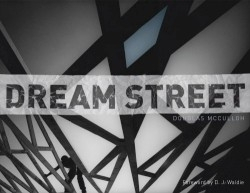Dream Street
After author and photographer Douglas McCulloh won the right to name a street in an about-to-be developed southern California suburb, he requested permission to make a photographic record of the project. The result is an indictment of the unscrupulous selling of the fabled “American Dream.”
McCulloh made 20 x 24-inch gelatin silver prints of his photos, hoping that, “[p]erhaps focus and craft would help me make sense of what Id seen.” His work places him in the lineage of noted photographers of the development of suburbia, and movingly chronicles the human costs of changes in the way houses are made, sold, and financed. McCulloh stands as witness to the turning of farmland into moon-like flats, and issues of “immigrant labor, construction wages in free fall, predatory lenders, and working-class flight from barrios and ghettos,” in a report that is at once timely and frightening in its implications.
In the foreword, D.J. Waldie writes that reformer Edward Filenes 1925 call to “Make houses like Fords,” began to be realized in the mid-1950s with the mass production of tract houses and mortgages financed by federal housing agencies and savings institutions. Ordinary people, “with nothing more to recommend them except their habits of hard work,” could now purchase a simple tract house, and thus become full-fledged participants in the American Dream, a dream which has become, for many, a nightmare.
McCullohs pictures and the stories that accompany them begin with the barren land that once belonged to Japanese-American farmers. These farmers arrived after enduring World War IIs infamous internment camps and a series of other heartbreaking losses. They grew strawberries, sweet corn, cabbages, cantaloupe, and melons on these forty acres. Later, the land became a San Bernardino County infill development beneath the flight path to the Ontario, California airport. Some of the neighbors interviewed remember picking strawberries there as children and lament the ruin of good farmland; others recall how the area, lately overgrown and littered with trash, had provided cover for those who cooked up homemade speed to sell to interstate truckers.
Signs of the imminent burst of the housing bubble are all around. The homes were built to attract first-time home buyers and “sketchy credit risks, many of whom are first-generation Americans or immigrants themselves.” In 1999, it was already uncertain who in that target market could afford the mortgage payments. Houses that originally sold for $130,000 were resold for $350,000 in 2006. By mid-2008, there were more than 200 houses in some stage of foreclosure in the surrounding zip code. One of the drywallers working to build Dream Street notes: “This is how America works: the people who build the houses cant afford one.”
As McCulloh follows the progress of the new development, he gains insider information about the lives, characters, and business dealings of those involved. He notes how kids with nothing better to do break the windows of construction vehicles and steal equipment and materials, and how the groundwater beneath the project is too polluted to drink. He chronicles the hopes and fears of the workers, once craftsmen and now working at low-wage piecework, and the families who come to look at the poorly built houses. The families dont seem to see the houses defects, but focus on the hopes they offer for better and brighter futures.
Douglas McCulloh earned a masters in photography and digital media from Claremont Graduate University. He has exhibited widely in the US, including at the California Museum of Photography, and in Europe, China, and Mexico. Three of his projects have received funding from the California Council for the Humanities, and he was one of six artists who transformed an F-18 jet fighter hangar into the worlds largest camera to create the worlds largest photograph.
D.J. Waldie is the author of Holy Land: A Suburban Memoir, Where We Are Now: Notes from Los Angeles, and other works. He is a contributing editor for the Los Angeles Times and a contributing writer at Los Angeles Magazine.
Reviewed by
Kristine Morris
Disclosure: This article is not an endorsement, but a review. The publisher of this book provided free copies of the book to have their book reviewed by a professional reviewer. No fee was paid by the publisher for this review. Foreword Reviews only recommends books that we love. Foreword Magazine, Inc. is disclosing this in accordance with the Federal Trade Commission’s 16 CFR, Part 255.

